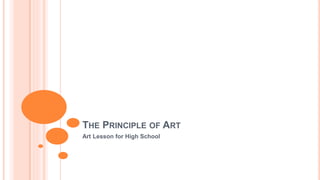
The Principle of Art.pptx
- 1. THE PRINCIPLE OF ART Art Lesson for High School
- 2. UNDERSTANDING THE PRINCIPLE OF ART The Principles of Visual Art are the set of rules or guidelines of visual art that are to be considered when considering the impact of a piece of artwork. They are combined with the elements of art in the production of art. The principles are movement, unity, harmony, variety, balance, emphasis, contrast, proportion, and pattern.
- 3. MOVEMENT Movement shows actions, or alternatively, the path the viewer's eye follows throughout an artwork. Movement is caused by using elements under the rules of the principles in picture to give the feeling of action and to guide the viewer's eyes throughout the artwork.
- 5. UNITY Unity is the wholeness that is achieved through the effective use of the Elements and Principles of Art. The arrangement of elements and principles to create a feeling of completeness.
- 7. HARMONY Harmony is achieved in a body of work by using similar elements throughout the work, harmony gives an uncomplicated look to a piece of artwork. Color Harmony or Color Theory is also considered a principle through the application of the design element of color.
- 9. VARIETY Variety (also known as alternation) is the quality or state of having different forms or types. The differences which give a design visual and conceptual interest: notably use of contrast, emphasis, difference in size and color.
- 11. BALANCE Balance is arranging elements so that no one part of a work overpowers, or seems heavier than any other part. 3 Kinds of Balance: 1. Symmetrical (or formal) balance is when both sides of an artwork, if split down the middle, appear to be the same. The human body is an example of symmetrical balance. 2. Asymmetrical balance is the balance that does not weigh equally on both sides. 3. Radial balance is equal in length from the middle. An example is the sun.
- 13. CONTRAST Contrast is created by using elements that conflict with one another. Contrast is created using complementary colors or extremely light and dark values. Contrast creates interest in a piece and often draws the eye to certain areas.
- 15. PROPORTION Proportion is a measurement of the size and quantity of elements within a composition. In ancient arts, proportions of forms were enlarged to show importance. This is why Egyptian gods and political figures appear so much larger than common people. The ancient Greeks found fame with their accurately-proportioned sculptures of the human form. Beginning with the Renaissance, artists recognized the connection between proportion and the illusion of 3-dimensional space.
- 17. PATTERN/RHYTHM Pattern and rhythm (also known as repetition) is showing consistency with colors or lines. It is indicating movement by the repetition of elements. Rhythm can make an artwork seem active.